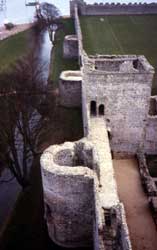 Geography made a unitary empire embracing the Mediterranean and temperate Europe inherently unstable; but the wreckage of the Roman Empire contained the building blocks of modern Europe. In the third and final part of our series based on Cunliffe’s new book, Europe between the Oceans, we chart the changes from Caesar to Charlemagne.
Geography made a unitary empire embracing the Mediterranean and temperate Europe inherently unstable; but the wreckage of the Roman Empire contained the building blocks of modern Europe. In the third and final part of our series based on Cunliffe’s new book, Europe between the Oceans, we chart the changes from Caesar to Charlemagne.
In the Punic Wars of the mid-late 3rd century BC, Roman imperialism erupted out of the Italian peninsula and won dominance over the Western Mediterranean. In the Macedonian Wars of the early-mid 2nd century BC, Rome established dominance over the Balkans and became a threat to the old Hellenistic kingdoms of Anatolia and Syria. By 140 BC, the Mediterranean was, for the Romans, mare nostrum — ‘our sea’.
An imperial interlude
Roman imperialism was self-feeding. Foreign wars generated huge wealth in the form of booty; and, as the empire expanded, the income streams to the central state from provincial taxation swelled. War captives provided slave labour for the estates of Italian aristocrats and the building projects of Roman warlords. Above all, ‘it was revenue from war that funded new wars. Rome was now inextricably caught up in the momentum of unlimited empire-building: this was to drive the state until the early 2nd century AD, when the emperor Hadrian decided to call a halt and begin to stabilise the frontiers.’
Such was the dynamism of the system that, under the Late Republic (133-130 BC) and the Augustan Principate (30 BC-AD 14), Rome was sometimes fighting two or more major wars at once. As well as pushing east to collapse the Hellenistic kingdoms and incorporate Syria, Egypt, and the Levant into the empire, and south, spreading their control along the North African littoral, the Romans also pushed deep into the northern temperate zone of the European heartland.
It was not always violent. Long before the soldiers came, there were traders buying slaves and furs from the ‘barbarians’ in exchange for Italian wine and Pompeian bronzeware. There is a dramatic increase in the number of wrecks found off the south coast of France which can be dated to the period after c.150 BC. Most were carrying mixed cargoes, but wine was dominant, often occupying more than 75% of the available space. One estimate is that Gaul imported 40 million amphorae of Italian wine in the course of a century, representing two million gallons per year.
‘They are exceedingly fond of wine,’ reported Diodorus Siculus of the Gauls, ‘and sate themselves with the unmixed wine imported by merchants; their desire makes them drink it greedily, and when they become drunk, they fall into a stupor… Therefore, many Italian merchants, with their usual love of cash, look on the Gallic craving for wine as their treasure. They transport the wine by boat on the navigable rivers and by wagon through the plains, and receive in return for it an incredibly high price, for one amphora of wine they get in return a slave — a servant in return for a drink.’
The Italian traders were serving an increasingly stable Celtic elite, which, since the 2nd century AD, had been constructing fortified proto-towns known as oppida. Excavations at Bibracte (Mont Beuvray) near Autun in Eastern Gaul have revealed a massively defended hilltop location carefully laid out with areas reserved for elite residences, communal meeting places, religious foci, and artisan quarters. As well as manufacturing a wide range of artefacts, imported Mediterranean luxuries were received and redistributed at the site. Bibracte was the capital of the Aedui tribe, who were pro-Roman, providing Caesar with a firm political and logistical base for his conquest of the rest of Gaul in the 50s BC.
Roman commerce won friends: Celtic oppidum-chieftains could consolidate their power by monopolising the inflow of imported luxuries. But others resisted, and the violence of conquest sometimes flared into a frenzy of genocide and enslavement. Plutarch estimated that Caesar’s eight-year campaign of conquest in Gaul involved the subjugation of 300 tribes, the storming of 800 settlements, the killing of a million people, and the enslavement of a million more.
The full article is in Current Archaeology 231



